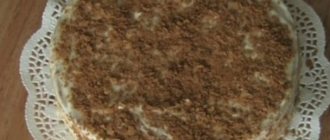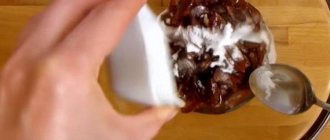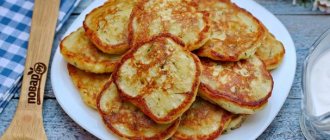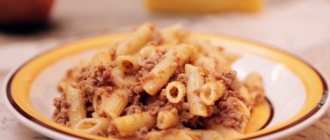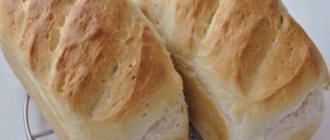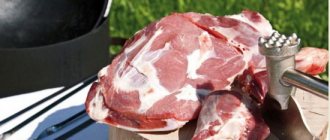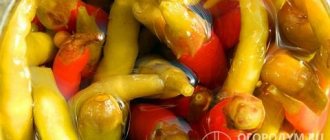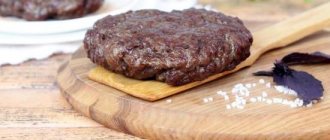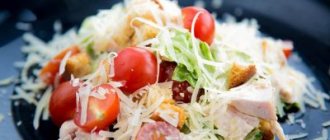For the bright holiday of Easter, many housewives traditionally bake Easter cakes and paint eggs.
This baking is ritual and is a rich bread, usually made from yeast dough. Raisins or candied fruits are generously added to it, and the top is decorated with beautiful colored powder or white fondant.
On the eve of Easter, such Easter cakes appear on store shelves everywhere. They look beautiful, but the taste is significantly inferior to homemade baked goods. Which is not surprising. Year after year, enterprising manufacturers strive to reduce the cost of products and choose the cheapest, low-quality ingredients for them.
I suggest baking this Easter butter bread at home. Unlike store-bought ones, homemade Easter cakes are soft, have a porous delicate structure and are very tasty. In this great selection of recipes you will find the best version of simple and sweet baked goods.
Delicious Easter cake for Easter 2021 in a slow cooker according to the simplest recipe
Cooking in a slow cooker is quick and easy, and the cake turns out tall, fluffy, bakes well and never burns. The peculiarity of this baking is the white crust on top. But you shouldn’t be afraid of this, since we will decorate it with icing. The sides turn out ruddy, golden in color; it’s up to you to cover them with glaze or not.
Ingredients:
- Chicken egg - 2 pcs.
- Granulated sugar - 200 g
- Milk – 250 ml
- Flour - 650 g
- Butter and margarine - 60 g each
- Vanillin – 1 sachet
- Dry yeast - 3/4 tbsp. l.
- Vegetable oil - 30 ml
- Salt - 1/2 tsp.
- Raisins and candied fruits - 50 g each or as desired
For the glaze:
- 1 egg white
- Granulated sugar - 0.5 tbsp.
- Take the butter and eggs out of the refrigerator and let them warm to room temperature.
- Dilute 2 tbsp in warm milk (no more than 40 degrees). l. dry yeast and granulated sugar. Sift the flour through a sieve and add 3-4 tablespoons to the dough. Stir until smooth and send the dough to a warm place to steep for 15-20 minutes, covering the top with a clean cotton towel.
- Meanwhile, prepare the raisins: rinse and soak in boiled water for 5 minutes. Then drain the water so that the berries have time to dry. For the recipe, use seedless dried fruit.
- Carefully break the eggs and separate the yolks from the whites. Add a pinch of salt to the whites and beat them into a light foam with a mixer.
- Separately, beat the yolks with a glass of granulated sugar.
- The dough has risen well, put it in a large saucepan. Add softened butter and whipped yolks and whites there. Mix the mixture, add vanillin and salt. Let's add flour, while stirring the dough with our hands. This takes approximately 15-20 minutes.
The dough should not be too tight, so be careful with flour - do not overdo it.
When the dough begins to lag behind your hands, pour in sunflower oil. Knead until it is completely absorbed into the lump.
- Add raisins and candied fruits and stir into the dough so that they are evenly distributed over it.
- Now cover the pan with a towel and put it in a warm place for 2 hours.
Make sure that there are no drafts in the house, otherwise the dough will settle.
- After this time, the dough increased significantly in volume. Let's wrap our hands around it and let it rise again for 1.5-2 hours.
- Grease the multicooker bowl to the very top with vegetable oil. We put our dough into it. Set the device to “Yoghurt” or “Multi-cook” mode for 20 minutes.
The temperature in these modes is 40 degrees, which allows the dough to rise.
Then, without opening the multicooker lid, set the “Baking” mode (at a temperature of 120 degrees), and the cooking time is 1 hour 20 minutes.
- Kulich rose to the very top in the bowl. It is well baked, its sides are ruddy with a golden tint.
- And we will fill the light top with glaze. Beat 1 egg white with half a glass of granulated sugar into a viscous, thick mass.
You need to start whipping at low speeds, then increase speed.
- Using a spatula, spread an even layer of glaze on top of the cake. There was a lot of glaze, enough for the sides.
- If desired, you can decorate your culinary creation with colored (store-bought) glaze by writing the letters XB.
- While the white fondant is not completely dry, decorate the top with colored sprinkles with candied fruits.
The Easter cake turned out very beautiful, tasty, airy, aromatic and well baked. Happy holiday and good mood!
Vienna cake
We will bake the most delicious Easter cake in the oven according to one of the old Viennese recipes with step-by-step photos.
Ingredients:
- milk – 250 ml;
- flour – 500 g;
- butter – 60 g;
- vegetable oil – 20 ml;
- eggs – 2 pcs.;
- sour cream – 20 g;
- sugar – 100 g;
- salt - a pinch;
- vanillin – 5 g;
- yeast – 1.5 tsp;
- raisins – 50 g.
Preparation:
- Separating the yolks from the whites, grind them with sugar and add sour cream and vegetable oil.
- Mix milk with melted butter, combine both mixtures and add yeast, previously diluted in a small amount of warm milk.
- We also add washed and dried raisins and beaten egg whites. Stir everything, cover with a cloth and leave overnight.
- From early morning, add flour, knead soft dough, leave for another hour.
- Place the finished dough into molds and bake at 200°C until golden brown.
Also read: Quick recipes for a slow cooker with photos
- Drizzle the Vienna cake with sugar or protein glaze and decorate it with bright culinary decorative elements made from sweet mastic.
How to bake sweet Easter cake with raisins in the oven
I bring to your attention a time-tested recipe for a delicious and fragrant Easter cake. You will spend some time preparing it, but it is worth it. Your family and friends will appreciate your efforts, because the baked goods turn out great - soft, tender, airy, with a light lemon aroma, it just melts in your mouth!
It is very important for successful baking to use only fresh ingredients. Here we use compressed yeast; when purchasing, pay attention to the date of manufacture, as well as its appearance. They should have a good smell and break easily. If the yeast stretches like plasticine at the break point, it is not suitable for baking.
The flour used is premium grade wheat flour. Before preparing the dough, it must be sifted to enrich it with oxygen. Then the baked goods will turn out more fluffy and airy.
Ingredients:
for the dough:
- 1 tbsp. l. - granulated sugar
- 55 g - live (pressed) yeast
- 100 g - warm milk
- 150 g - wheat flour
for test:
- 250 g - granulated sugar
- 5 g - salt
- 200 g - warm milk
- 250 g - margarine or butter (softened)
- 1/4 tsp. - vanillin or a packet of vanilla sugar
- 4 things. - chicken eggs
- 0.8-1 kg - flour
- 1 PC. - lemon
- 300 g - raisins
for greasing Easter cakes:
- 2 pcs. - egg white
- 2 tbsp. l. - granulated sugar
- 1 tsp. lemon juice
- Products should be removed from the refrigerator in advance to keep them warm, as the dough ripens better in the warmth. For the same reason, we heat the milk to 35-40 degrees, but not more, otherwise you can kill the yeast.
- To activate the yeast, add 1 tsp. granulated sugar and 3 tbsp. l. warm (about 40 degrees) milk. Mash the ingredients with a fork and leave for 8 minutes.
- Let's prepare the dough: add 1 tbsp to half a glass of warm milk. l. sugar, 150 g of sifted flour and activated yeast. Mix the ingredients.
The consistency of the dough should resemble pancake batter. If the mass turns out thick, dilute it with milk.
Carefully wrap it in a towel or cling film and place it in a warm place for half an hour. Draft is not allowed!
- While the dough is rising, squeeze 1 tsp from half a lemon. juice And grind the lemon itself (removing the seeds from the fruit) through a meat grinder. Add 2 tsp to the lemon mixture. granulated sugar and vanilla sugar to taste, mix everything.
- Soak the raisins in warm water for 8 minutes. Then salt the water and spread the berries out to dry.
- Let's start kneading the dough. Beat eggs in a wide bowl, add sugar and salt. Mix with a whisk and pour in warm milk. Add some of the sifted flour and softened margarine.
Instead of margarine, you can use butter or half of both products.
We will also mix the dough that has arrived at this time into the products. Continue stirring the dough and adding flour until it becomes thick. Then we move on to kneading it on the table.
To prevent the dough from sticking to the surface, add a little flour.
- Knead until it becomes elastic. Let's make a lump out of it and leave it in a warm place for 20 minutes. Don't forget to cover with film or a towel.
- After this time, add lemon with vanilla and raisins to the dough. Knead it well so that the berries are evenly distributed. Then place the dough in a warm place for another 45 minutes.
- After the specified time, we begin to divide the dough into pieces to fill half of the prepared baking dishes. In this case, paper baking pans are used.
To make the work easier, it is better to lubricate your hands with vegetable oil.
Roll each piece on the table and place it in the form of a bun in the mold. Let the dough rise for half an hour in a beautiful shape and immediately place it in an oven preheated to 180 degrees for 40 minutes.
- While the cakes are baking, prepare the icing for them. Carefully break two raw eggs and separate the whites from the yolks. Pour 2 tablespoons of granulated sugar and 1 tsp into the whites. lemon juice. Beat into a homogeneous thick mass.
- Using a pastry brush, cover the cakes with white glaze. If you wish, you can additionally decorate them with bright sprinkles, candied fruits, coconut or nut shavings.
Cottage cheese cake with tangerine zest
You can bake the most delicious Easter cake with cottage cheese in the oven using a simple, proven recipe with step-by-step photos.
Ingredients:
- cottage cheese – 250 g;
- flour – 350 g;
- milk – 60 ml;
- eggs – 3 pcs.;
- sugar – 150 g;
- butter – 50 g;
- vanillin - a pinch;
- yeast – 1 tsp;
- salt – 2 pinches;
- dried apricots – 100 g;
- tangerine zest – 1 tsp.
Preparation:
- Prepare the dough using warm milk with yeast, sugar, salt and a small amount of flour. Mix everything and leave to start fermentation.
- When the dough is covered with foam, add cottage cheese mashed until smooth, two whole eggs and one yolk, after stirring them. Also add melted butter to the dough and stir.
- Add flour little by little, knead a soft elastic dough, leave for one and a half to two hours in a warm place.
- During this time, knead the dough a couple more times, at the last kneading add chopped dried apricots and tangerine zest.
- Place the finished dough into the molds and leave for half an hour.
- Bake the cakes at 180°C until golden brown (the exact time depends on the size of the molds and the features of the oven).
- We decorate the Easter cakes with protein glaze, using the remaining protein, as well as other options for decorating Easter cakes.
The most delicious Easter cake recipe in a bread machine
The cake comes out of the bread machine as tall and fluffy as when baked in a slow cooker. At the same time, preparing it is much easier than in a multi-cooker. You don’t have to knead anything with your hands; the machine will mix and bake everything for you. Just a godsend for busy housewives!
Ingredients:
- First, pour liquid products into the bowl: melted butter, warm milk and raw eggs. Then add salt, granulated sugar and sifted flour. At the very end, add dry yeast. We place the bowl in the appliance, close the lid and in the “Kulich”, “Dark Crust” mode we let the kitchen assistant work for 2 hours 20 minutes.
- The bread maker will beep after a while. This means it’s time to add any filling to the dough: raisins, candied fruits, nuts or dried apricots. Open the lid of the device and, without turning off the bread maker, put pre-steamed and completely dried raisins into it, into which we mix a little flour.
- By the time the product is prepared, we will prepare the glaze for it. Carefully break the egg and separate the white from the yolk. Add a pinch of salt to the protein and beat it with a mixer. Without stopping working with the mixer, pour in granulated sugar - 2 tbsp. l. Beat into a viscous mass until stable peaks form. Remove the cake from the appliance.
- Before it cools down, apply glaze on top - this way it will dry faster.
- Decorate with beautiful confectionery powder. The cake turned out to be very tender, with a porous structure and moderately sweet.
How to knead Easter cake dough
The longer you knead the dough, the tastier and softer the cake will be. In Rus', women kneaded the dough up to 100 times. Modern housewives never even dreamed of such culinary feats! And you don’t need to spend so much time and effort - just watch the dough carefully, and as soon as it becomes elastic enough and does not stick to your hands, it can be considered ready. The more the dough is saturated with air, the fluffier the baked goods will be. It is best to knead the dough with your hands, without kitchen equipment, because Easter cakes love the warmth of human hands.
Add flour more carefully, because too tight a dough will result in a dense cake that will quickly become stale. But a liquid texture is also not welcome, since in this case the cakes will not hold their shape and will not rise well. The required consistency of the dough is ensured by the addition of eggs or flour, and the standard of density is the state when the dough can be cut with a knife, but is still soft. Don’t be afraid to thin the dough with eggs - Easter cakes especially love them; it’s no coincidence that 4 to 15 eggs are always added to 1 kg of flour. We don’t bake bread, but holiday pastries!
Grandma's Easter cake. Step by step recipe
Who has the most delicious baked goods? Of course at grandma's! Such culinary recipes were written down in a separate notebook, carefully stored and passed on from generation to generation. So today I want to invite you to prepare Easter cake according to one of my grandmother’s recipes. It produces surprisingly tasty and tender baked goods with a light citrus aroma.
Ingredients:
for test:
- Eggs - 6 pcs. + 2 egg yolks
- Milk – 400 ml
- Margarine or butter - 200 g
- Fresh yeast - 65 g
- Flour - 1000-1250 g
- Granulated sugar - 250 g
- Raisins – 300 g
- Vanilla sugar - 1 sachet
- Zest of 1 lemon
- Salt - ½ tsp.
for glaze:
- Egg whites - 2 pcs.
- Citric acid powder - 1/3 tsp.
- Sugar - 150 g
- Let's heat the milk and margarine in the microwave (you can replace it with butter).
- We beat the eggs into a bowl, and carefully separate the whites from two eggs and put them in the refrigerator for icing. Add sugar, salt and grated zest of one lemon to the egg mixture. Then pour the heated milk with melted margarine.
- Pour in the yeast and begin to add the sifted flour in parts. We need to knead a not very tight dough. Cover it with a lid and let it rise for 50 minutes.
- After this time, grease your hands and table with vegetable oil and divide the dough into 3 parts.
- Roll the dough into a thick sausage and place it in a baking dish. The dough should fill 2/3 of the container, and 1/3 should be left to raise the tall cap of the Easter cake.
- Place the molds with the dough in a warm place so that it rises a little.
- Then place in an oven preheated to 200 degrees for half an hour. You can check the readiness of the products with a wooden toothpick - it should come out dry from the baked goods.
- While the cakes are baking, let's prepare the glaze. Using a mixer, beat the whites with sugar. At the very end, for stability, add a little citric acid to the mass.
- Remove the finished cakes from the oven.
- Immediately apply the glaze on top - this way it will harden faster and more reliably. We decorate the top with beautiful sprinkles.
Classic Easter cakes
The most delicious, melt-in-your-mouth Easter cakes made with live yeast, prepared according to a classic recipe with step-by-step photos.
Ingredients:
- flour – 2 kg;
- full fat milk – 1 l;
- live yeast – 100 g;
- butter – 100 g;
- fat sour cream – 1 tbsp.;
- cream margarine – 200 g;
- sugar – 3 tbsp;
- vanilla sugar – 2 sachets;
- eggs – 8 pcs.;
- raisins – 300 g;
- powdered sugar – 300 g;
- sunflower oil – 100 g;
- confectionery sprinkles;
- salt – 1 tsp.
Preparation:
- Easter cakes according to this recipe will turn out so tasty that it is better to cook them in large quantities at once. In warm milk we dilute yeast and 6 tablespoons of sugar, immediately add flour (in the case of dry yeast, you need to wait until fermentation begins and then add flour) to get a liquid mass.
- While the dough is rising, we prepare another mixture, which consists of eggs (we remove two whites for glaze), the remaining sugar and vanilla sugar, salt, vanillin, sour cream and melted butter with margarine.
- It is better to knead this amount of Easter cake dough immediately in a large container. Mix both prepared masses, add flour and washed and dried raisins.
- Knead the soft pliable dough, generously greasing your hands with sunflower oil.
- Knead the dough again two or three times after it has risen thoroughly.
- We spread the dough into the available forms, filling it no more than a third. Leave the dough in the molds for half an hour.
- Bake the cakes in the oven at 180°C for 25 to 35 minutes, depending on the size of the molds.
- Grease the finished Easter cakes with egg white whipped with sugar, which should preferably be heated in a water bath for 5-7 minutes. We decorate Easter cakes traditionally, using culinary sprinkles, pieces of dried fruit or candied fruit.
Preparing the Tsar's Easter cake for Easter
The name of the dish speaks for itself and a royal treat is prepared from the finest ingredients. Instead of milk, 20% cream is used. Butter and wheat flour are taken of the highest quality. It is advisable to buy oil from a farmer's farmstead.
For flavor, we will add the zest of one lemon to the dough. The result is fragrant, airy, tall Easter cakes, which will become the main decoration of the holiday table.
Ingredients:
- First we activate the yeast. Add 1 tbsp to warm cream (150 ml). l. (with a slide) granulated sugar with dry yeast, mix. Leave in a warm place for 10-15 minutes.
- In a separate container, beat 6 eggs and 2 yolks (we will need the whites for fudge), add sugar and a bag of vanilla sugar. Let's beat with a whisk or a kitchen assistant, whoever has what on the farm.
- Pour the activated yeast, the rest of the cream, melted butter, beaten yolks with sugar and lemon zest into a wide bowl. We will gradually introduce the sifted flour until the dough becomes quite thick - a little thicker than for pancakes.
- Add seedless raisins and mix them well into the dough. Cover the dough with a towel or film and place it in a warm place for 1-1.5 hours.
- During this time the dough will increase in volume.
- You can place them in baking dishes, filling them to one third of the volume.
- Cover the molds with a towel and leave in a warm place for another 30 minutes.
- We send the risen products to bake in an oven preheated to 180 degrees for 40 minutes.
If you have molds of different sizes, small cakes will bake faster. To prevent them from burning, you can cover the top with parchment or foil.
- Meanwhile, prepare the glaze. Beat the sugar with the chilled egg whites into a white, thick, fluffy foam. Turn the cooled cake upside down and dip the cap into the glaze.
- We decorate the top with any topping: culinary colored crumbs, candied fruits, pieces of small marmalade, coconut flakes...
Easter cake with live yeast
Let's prepare the most delicious Easter cake using live yeast according to one of the popular recipes with step-by-step photos.
Ingredients:
- flour – 3.5 kg;
- homemade milk – 1.5 l;
- butter – 300 g;
- sugar – 1 kg;
- live yeast – 50 g;
- eggs – 5 pcs.;
- vanillin – 3 sachets;
- raisins – 200 g.
Preparation:
- Mix the milk, previously boiled and cooled to 38 °C, with a small amount of flour to form a liquid mass.
- We dilute the yeast in warm water with a glass of sugar until the mixture is homogeneous. We combine both masses and leave for fermentation.
- Add eggs, mashed with the rest of the sugar, as well as melted butter, vanillin and raisins to the risen dough, stir thoroughly.
- Pour flour into the prepared dough base in portions and knead, lubricating your hands with vegetable oil.
- Having kneaded a very soft sticky dough, leave it in a suitable container for a couple of hours, doing two kneads during this time.
- The third time the dough will rise in the molds, where we will first spread it, filling it to a third of the volume.
- Place the risen dough in the molds in the oven, preheated to 220°C, for 10 minutes, then reduce the heat to 180°C and bake for 35 minutes.
- We decorate the finished Easter cakes to your liking and serve them at the festive Easter table.
The best recipe for rich cottage cheese cake (without yeast and raisins)
Cottage cheese cake without yeast tastes like a cupcake. The baked goods turn out rich, so there is no need to add raisins to it. But if you wish, you can add any dried fruits or candied fruits to the dough.
Ingredients:
Beat the eggs into a wide bowl, add granulated sugar and vanilla sugar and beat with a mixer into a homogeneous mixture. Then add softened butter and turn on the device again. Next will be cottage cheese, add it to the bowl and beat with a mixer.
Now we move on to manual kneading, add baking powder and begin adding sifted flour.
The dough has become thick and can be poured into molds.
The oven should already be preheated to 180 degrees by this time. Send to bake for 40 minutes.
You can simply sprinkle cottage cheese cakes with powdered sugar. And if you decide to make them more elegant, with icing and colored sprinkles, see the recipes above.
Spices for Easter cake
Another integral quality of this Easter cake is its unique aroma. In Greece, the obligatory Easter cake spices are mahlab and mastikha (mastic) .
Mahlab or mahleb is a traditional oriental spice made from the kernel of a certain variety of wild cherry. It tastes like a mixture of bitter almonds and cherries. In the east, it is often added to yeast baked goods.
Mahleb
If you are a lover of traveling to eastern countries and you have a mahlab lying around, it’s time to put it to work.
Mastiha is a purely Greek spice, resin from the mastic tree, and has a very specific but pleasant aroma.
Mastiha
We will omit these spices and add vanilla, orange zest that is available to all of us and, if desired, we can add cardamom.
Cardamom
I also added raisins and candied fruits. Kulich became fire!
The recipe is very simple and quick, especially if you have a planetary mixer.
And following the links you can find the sensational recipe for long-fermentation panettone and the even more sensational Easter cake craffin.
How to make delicious Easter cakes with cognac?
You can make fragrant Easter cakes if you add a little cognac to them. And if you have small children, then don’t worry and feel free to add this drink to your composition. During cooking, the alcohol will evaporate, but the aroma will remain.
The recipe is not complicated. And everyone can do it. Even with such an abundance of necessary ingredients, you will still get this wonderful pastry that just melts in your mouth.
Ingredients:
Preparation:
1. First of all, let's prepare the dough. To do this, crumble fresh yeast into warm milk. If you take dry ones, then take 3 times less.
Then add 1 tablespoon of the total amount of sugar to the milk and mix. Then add 3 tablespoons of flour, mix until smooth and cover with a lid.
Leave in a warm place until the mass increases by 2.5 times.
If the yeast is good, then this will take 15-20 minutes.
2. Break the eggs into a deep bowl and add the remaining sugar to them. Add salt and vanillin. Then beat the sugar and eggs into a fluffy foam, about 5 minutes. Then add the softened butter.
3. Add sour cream, cognac and turmeric. Using a mixer, mix all ingredients until smooth. The mixer speed should be minimal and 10 seconds will be enough.
By the way, you don’t have to add turmeric at all. In fact, it does not provide any taste or smell. The only thing that turmeric provides is a bright color. It turns out very beautiful.
4. At this stage, add the dough and mix. After this, make a hole in a bowl with flour and pour our mixture into it in small portions. This way we knead the dough.
5. At the moment when all the flour has been absorbed, dust the table with a small amount of flour and begin kneading the dough with your hands. As soon as the dough comes together, pour vegetable oil on it and continue kneading. If necessary, you can add a little more flour.
As a result, the dough should be soft and homogeneous, elastic and practically not sticky to your hands.
6. Place the finished dough into a deep bowl, which we first grease with a small amount of vegetable oil. Cover with cling film and leave to proof until it increases in volume by 2-2.5 times.
Place the risen dough on the table and stretch it into a layer.
7. Rub the raisins with a small amount of flour and place them on a layer of dough along with the candied fruits. Fold the dough and knead it for a couple more minutes so that all the additives are evenly distributed throughout the entire volume.
8. Just as usual, fill the cake molds 1/3 full. Or, if you want moister cakes, fill them halfway. Cover the molds with film and leave until doubled in size.
Place the risen cakes into a preheated oven and bake until fully cooked. We check readiness with a wooden stick or torch.
9. Remove the finished cakes from the oven and cool them, placing them on their sides. From time to time we roll them from place to place so that the sides do not wrinkle.
10. Grease the completely cooled Easter cakes with any glaze that you like and taste. You can use any recipe from today's selection.
11. Immediately sprinkle the finished Easter cakes with powder or colored millet.
Leave the cakes aside until the glaze has completely hardened. Otherwise, all our preparations have come to an end.
This is what the Easter cakes look like in cross section. See how beautiful they turned out. Moderately sweet and moist. Very aromatic and, of course, very tasty. Bon appetit and happy baking!
Master class: preparing Easter cakes
The Christian holiday of Easter is approaching, and housewives are already putting butter dough on Easter cakes. There are many recipes for making Easter cakes, but despite the different composition of the dough, the right Easter cakes turn out fluffy, tall, rosy and well baked. In addition, homemade Easter cakes are always tastier than store-bought baked goods, because they are prepared with your own hands, with love and in a peaceful mood. We have already told you how to prepare Easter cake at home so that it rises and bakes well, but today we’ll talk about how to properly bake Easter cake and decorate it festively. Easter baked goods should be beautiful, bright and impressive!
Easter cakes with kefir without eggs and yeast according to a simple recipe
Now let's prepare Easter cakes with kefir without eggs. A great option for those with egg allergies. Well, or some other reason why you don’t use eggs in your diet.
But in this recipe we will use raisins and poppy seeds, which will make the cakes very tasty. Let's start understanding the cooking steps.
Ingredients:
- Raisins - 150 gr.
- Sugar - 250 gr.
- Flour - 750 gr.
- Kefir - 600 gr.
- Poppy – 25 gr.
- Tea soda - 1 tsp.
- Baking powder - 1 tbsp.
Preparation:
1. Pour baking soda into kefir. Mix and leave aside.
2. Sift the flour through a sieve.
And sprinkle a small amount of pre-washed and dried raisins.
3. Mix the raisins and flour thoroughly. This will ensure that the raisins are evenly distributed throughout the dough.
4. Pour baking powder into flour and mix.
5. Next, add sugar to the flour and mix. If you like your cakes sweeter, you can add more sugar.
6. Next add raisins and poppy seeds to the flour. Mix.
7. Now pour kefir and soda into the dry mixture.
And knead the dough.
8. Grease the baking molds with a small amount of vegetable oil.
9. Fill the molds halfway with the resulting dough. Well, or a little more.
10. Place the molds with the dough in an oven preheated to 180 degrees for 40-50 minutes.
11. Remove the finished Easter cakes from the oven and let them cool completely.
12. In the meantime, we can start preparing the glaze. To do this, add 40 grams of corn starch to 150 grams of powdered sugar and mix. Pour in 40 grams of kefir.
13. And mix.
The color of the icing comes from the brown sugar from which the powder is made. If your sugar is white, then the icing will also turn out white.
14. Now all that remains is to add 1 teaspoon of freshly squeezed lemon juice.
15. Beat the glaze with a whisk or mixer for 3-5 minutes.
16. Dip the cooled Easter cakes in glaze.
We do the same with the rest of the Easter cakes.
17. Decorate Easter cakes with whatever you like. Here are some examples of decoration. The first photo shows coconut flakes.
This is just regular confectionery powder.
And here is a version with colored millet.
Choose any one you like. Or better yet, take advantage of all the decoration options. The cakes turn out quite dense and moderately moist.
How do you like this Easter cake recipe? Would you cook this recipe?
How to make Easter cake topping
The easiest way to decorate an Easter cake is to sprinkle the product with powdered sugar or cocoa powder through a strainer or using holiday stencils. Simple topping options include poppy seeds, coconut flakes, colored sugar, ground nuts, dried fruits, candied fruits and regular store-bought confectionery toppings. First, the cake is covered with icing or fondant, and after a few minutes, when the glaze thickens slightly, you can sprinkle the top of the cake with something tasty. If you do this earlier, the sprinkles will drown in the glaze and will be invisible.
Easter cake decorated with patterns made using sugar pencils of all shades looks very impressive, and children will be happy to take part in this interesting activity. You can also decorate Easter cookies with sugar pencils.
You can decorate the Easter cake before baking with dough borders, braids, crosses and flowers, but the dough for decoration should be denser so that the decorations do not blur. By the way, it is better to attach braids and flowers using raw egg white.
The most creative housewives can make decorations from marzipan or mastic, decorate the Easter cake with fresh flowers, and decorate it with lace, ribbons and candles. In this case, the Easter cake can be turned into a real work of art.
Video on how to cook a simple and delicious Easter cake in the oven
Now I would like to show you the recipe in video format. I found it on YouTube. From the description, and from the result, it is clear that the cakes really turn out excellent.
But whether to repeat this recipe or not is up to you. Well, I, in turn, will write for you under this video the necessary ingredients to make it more convenient for you.
Ingredients:
- Eggs 8 pcs.
- Milk 500 ml.
- Butter 250 gr.
- Sour cream 500 gr.
- Sugar 450 gr.
- Vanilla sugar 3-4 sachets.
- Salt 0.5 teaspoon.
- Dry yeast 15 grams (fresh 50 grams).
- Flour 1400 g (different flour, but not more than 1600 g).
- Raisins 250 gr.
Decoration:
- White from 4 eggs
- Sugar - 200 gr.
- Citric acid - a pinch
- Salt - a pinch
On this note, I want to end today's post. It turned out to be very large and with quite a rich selection of Easter cake recipes. I think you will like at least one of them. And this will mean that the article was not written in vain. And if so, then please leave your opinion and share these recipes with your friends. It’s not difficult for you, but for me it’s very important.
Thank you for your attention. Happy baking. And I congratulate you on the holiday of Easter! Until next time.
Bye!
Author of the publication
offline 13 minutes
How can you bake Easter cake?
It is necessary to select in advance the form in which the cake will be baked. In Soviet times, housewives baked Easter cakes in saucepans, mugs, ceramic flower pots, and cans, and it turned out very well - small Easter cakes resembled church domes and looked very original. Until now, many grandmothers continue to bake in cans, not recognizing modern baking dishes.
Traditional Easter cake molds resemble cylinders of different volumes and sizes, silicone or metal, with a non-stick coating or a removable bottom. Don’t get carried away with too tall shapes - the height of the container should be about 1.5 times higher than the width, but no more than 20 cm.
Paper forms made from thick paper that is resistant to high temperatures, moisture and grease are also very popular. Many of them have a corrugated bottom and small holes for air circulation, because the cake must breathe. It is customary to take Easter cakes in beautiful paper forms with you when visiting and give them as an Easter souvenir. You can bake homemade cakes in regular muffin tins or disposable aluminum foil molds, which are convenient because they do not need to be washed after use.
